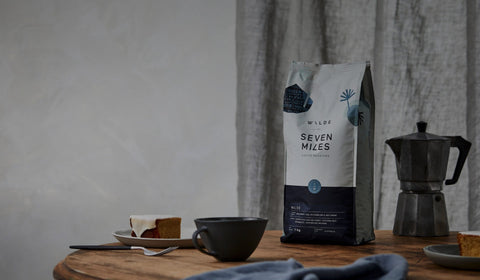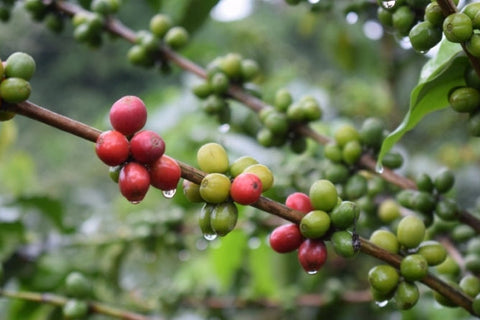Many, many years ago, a goat discovered a coffee tree in Abyssinia, Ethiopia. Khaldi, the goat’s herder, noticed the goat prancing in an excited state and to see where its newfound euphoria came from, Khaldi tried some of the cherries it was eating... and so, coffee was discovered.
Whether you believe this story or not, what is important to understand is that most Arabica coffee came from Ethiopia, Sudan and Yemen. In fact, the majority of coffee seems to step from these origins and are either natural mutations or manmade hybrids of these. So many coffee varieties now exist that it would be impossible to cover them all in a single article…
So let’s talk about some of the most common varietals that you will come across - to give you a starting ground, if you will.
Typica
This is a natural mutation of trees that were cultivated in Yemen. Typica’s spread around the world is predominantly due to the Dutch cultivating it in Indonesia and the French importing it to the Caribbean. From there, it quickly spread to Central and South America. Typica is a lower yielding plant, so finding it as a single varietal is rare, and it’s also susceptible to leaf rust. The cherry has a conical shape unlike most other varietals. The farms that do grow it do so because it produces some amazing coffee. It generally demonstrates outstanding sweetness, clarity and high quality acidities when grown in the right conditions.
Bourbon
Bourbon, like Typica, is a natural mutation of coffee originating from Yemen. It gets its name from being originally planted on the island of Bourbon, which is now called Reunion Island. Being French colonised, it was the French that also took it to other parts of the world, predominantly the Americas. The Bourbon cherry is short and round, and usually a dense cherry and seed. Bourbon usually are sweeter, with a pronounced acidity. The tree produces 20%-30% more than is typical but is still seen as a lower yielding plant, whilst also being prone to leaf rust. The majority of Bourbon cherries are red, however there are two other natural mutations of the Bourbon: the orange Bourbon and yellow Bourbon. The orange generally has more sweetness and the yellow has higher acidity.
Caturra
From Bourbon and Typica, there are a long line of natural and man-made mutations; caturra being one of them. Caturra is a natural mutation of the Bourbon varietal that was discovered in Brazil. It is more commonly found in Central America as it thrives in that part of the world. The tree is a dwarf, making it a lot easier to harvest, and also yields a lot more than Bourbon. For this reason, it has less body and sweetness than a Bourbon but a very crisp, clean and high quality acidity.
Maragogype
This a popular mutation of the Typica varietal pronounced marra-go-jee-pay. It’s best known for being a really big bean however the tree is lower yielding. When roasted, the bean looks twice the size of most Bourbon and typica varietals. It’s a general belief that the bigger the bean, the more flavour, but this may not be the case. Maragogype definitely do add body to a coffee and in an espresso blend, they will add to a blends overall complexity.
Mundo Novo
This bean is a natural hybrid between Red Bourbon and Sumatra Typica. It’s a popular varietal, particularly in Brazil where it makes up around 40% of Arabica grown in the country. It’s a high yield tree, producing around 30-40% more than Bourbon. It also has good resistance to disease. Generally the flavour lacks sweetness which is probably due to the large amount of cherries the tree is producing.
Catuai
A cross between Mundo Novo and Caturra, this varietal is more known for its production and less for its flavour. If looked after, it can have a uniquely good flavour with lots of sweetness. Catuai is best known for its strength - the cherries hold to the tree in high wind and rain areas, making it a safe crop.
Catimor
A cross between Timor; a natural robusta mutation, and Caturra; created in a lab in Portugal. It’s generally grown because of its resistance to disease and pests, plus its ability to grow in many different conditions. It is high yielding and easy to care for, but not well known for its flavour, as it generally has a sharp acidity and sometimes astringency. It is, however, a good example of what can be done in lab conditions.
Castillo
Another lab coffee and probably a slightly more successful one than Catimor is Castillo. If you follow its origins, it comes from a long line of lab mutations and hybrids, beginning at the Catimor. Cenicafe, Colombia’s National Coffee Research Centre, have been on a hunt for a coffee that is resistant to disease and pests, and grows easily in many conditions. Whilst Castillo hasn’t gained a lot of momentum for flavour, there are a handful of producers in Colombia that have been working on varietal-specific-cultivation and processing and the quality bar on flavour is being lifted continually.
Pacamara
This varietal was created in the El Salvador Institute for Coffee Research. It’s a cross between Maragogype and Pacas; a natural mutation of the Bourbon varietal. It looks like the Maragogype but unlike this varietal, which can be somewhat underwhelming, the Pacamara is a very popular coffee for its floral aromatics, sweetness and high quality acidities.
SL 28 and SL 34
Between 1930 and 1960, Scott Labs was contracted to do research on Kenyan coffee and the region. The result? Two famous man-made hybrids which are a cross between Bourbon and Ethiopian Heirloom varietals. Both aren’t high yielding with SL 34 yielding more than SL 28. Neither are particularly resistant to disease either; it’s really flavour they are after. They are both stars in Kenyan coffee and responsible for around 90% of exported Kenyan green beans. Sweet, aromatic and complex.
Gesha
Probably one of the most highly sought after varietals, Gesha (or Geisha as it is commonly spelled) is a heirloom Ethiopian Varietal. It was first discovered in Gesha (or Abyssinia) and is most well known for being very low yielding. Most farms took out the Gesha varietal in favour of higher yielding trees, but it made its way to Central America and in Panama it has played its biggest part. One particular producer in Panama, La Hacienda Esmeralda, is very well known for producing some of the world’s best and most highly priced coffees. Their Gesha has won many ‘Best of Panama’ competitions and is well known for its very distinctive bergamot, jasmine and peach characteristics.
Just the beginning
This really is the tip of the iceberg in terms of varietals but a good look at the majority of coffee traded and the coffee you are drinking today. Each coffee also has the ability to be region-specific… something I’ll cover in a future blog post.













